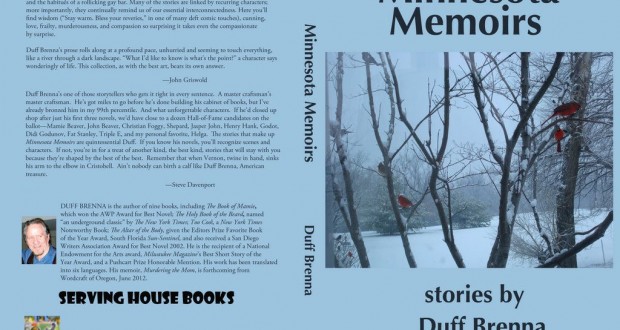 Book: Minnesota Memoirs
Book: Minnesota Memoirs
Author: Duff Brenna
Publisher: Serving House Books
DISCLAIMER: This book contains quite a few adult scenes and language. Not recommended for a traditional, Christian reader.
I discovered “Minnesota Memoirs” when this collection won first place in the Next Generation Indie Book Awards (my collection, “Amidst Traffic” placed as a finalist in the same competition). Coincidentally, I’ve had a run-in with Duff Brenna in the past, though not directly. Back in 2008, my short story, “Lost in the Night” was published in Hopewell Publications’ “Best New Writing 2008.” Brenna’s wife, R.A. Rycraft, had her own short story published in that same collection.
“Minnesota Memoirs” starts out with a tale set in the mid 1800s, written in traditional fashion but tinted with a bit of folklore. The story recounts the event of a man living in the woods with his sons near a tribe of Indians. One day, the Indians come to him to have their knives sharpened, only to turn around and slaughter a village of eighty people. The main character, who is a strong believer in honoring his family name, knows that his lineage has been forever tainted. From this, a theme is born that reappears throughout the collection: Characters desiring to overcome their own fallibility or trying to achieve a more-worthy destiny.
“Thirty pieces of silver kept echoing in Fergus’s head … He said that Minnesota history would always associate him with the eighty deaths of innocent men, women and children.”
Interestingly, two of the main characters’ last names in this tale are Foggy and Story, which appear again as the last names of secondary characters is several other stories in the collection.
Initially, it’s hard to make out exactly how this first story sets the tone for the rest, especially because the remaining stories are much more contemporary (even experimental) in style. “Tattooed,” for example, is told almost entirely in dialogue: A man tries to convince his adolescent step-son into getting a tattoo because it will make him more manly and desirable to women. In “Ways of Looking at a Blackbird,” a young man visits a house/inn managed by two old men and an elderly woman with the intention of killing and robbing, but gets swept away by one of the old men’s poetic (and crazy) theories of looking at black birds. In “Lives of the Cougar,” the story’s structure shifts back and forth in such a way that the story’s hopeful ending is dashed away by its very opening. In “Go To Girl” the story literally ends in mid-sentence (I’m still trying to figure out whether that’s a glitch with the Kindle version or not).
The prose itself is firm, driving the reader forward:
Being around other boys often brought out Pete’s acids, the suffocating meanness and anger chewing his insides … Pete relished the fear his actions caused others.
The knife in his pocket pulls at him like chaos. If he stabbed the old man, the blade would find six inches of fat first.
It’s Alice’s last day above ground and there will be no sun to warm her coffin.
Where these stories excel is in Brenna’s wonderful ability of creating lively characters who are (at times) totally crazy and yet extremely believable. A reoccurring theme in each character is how they’re hopelessly driven by their own impulsivity, often sealing their fate despite their conflicting desires. Each character, in his own way, desires a different future. Each of them wants to create his own fate. But somehow that inner desire comes in conflict with a kind of blinding flaw that he simply cannot overcome.
Whether it was sexual impulsivity, worldly ignorance, downright selfishness, self-righteous egomania, uncontrollable anger or sheer stupidity, it seems as though every character has written his fate from the moment the story begins. And yet, despite their incorrigible flaws, these characters find a way of gaining cheer or hope from the reader. One thing that I found both strange and interesting is how a few stories took on a hint of Christian redemption (such as the born-again narrator in “Behind the Green Door” and the Christian wife columnist in “Bodies in Motion”), and yet this Christianity is mostly scoffed by the majority of the characters, and (perhaps) by the author himself. I didn’t know whether a commentary was being made here, or whether this was mainly used to build complexity into the characters’ moral struggles.
I do think that this collection becomes more powerful as it goes along. It’s not necessarily that each story is better than the previous one, but as a reader I came to appreciate Brenna’s clever tendencies and style as I became more familiar with them. At times, I even paused and was struck with a sense of praise for his execution of subtle and poignant moments.
Toward the end, seven of the final stories are immediately connected, revolving around three main characters involved in adultery. And yet, as much as I wanted to hate some of these characters (either for their bombastic egotism or their foolish sexual desires), Brenna finds a way to make you feel compassion for them at the end. Or even forgiveness. Sometimes, Brenna’s writing simply steals your emotions and make you feel things you didn’t expect you’d feel.
At a point, I did question whether these seven stories really belonged in the collection considering they felt more like a novel told through different perspectives, but I think Brenna’s decision to include them is justified because each “chapter” really could stand alone if it had to.
In the end, this collection deserves the awards it received and five stars to go with it for one major reason: Brenna executes a complete collection that includes various styles of writing, structure and a whole slew of memorable characters.
 Michel Sauret – Award-Winning Army Journalist | Independent Author Award-Winning Army Journalist, Independent Author
Michel Sauret – Award-Winning Army Journalist | Independent Author Award-Winning Army Journalist, Independent Author






